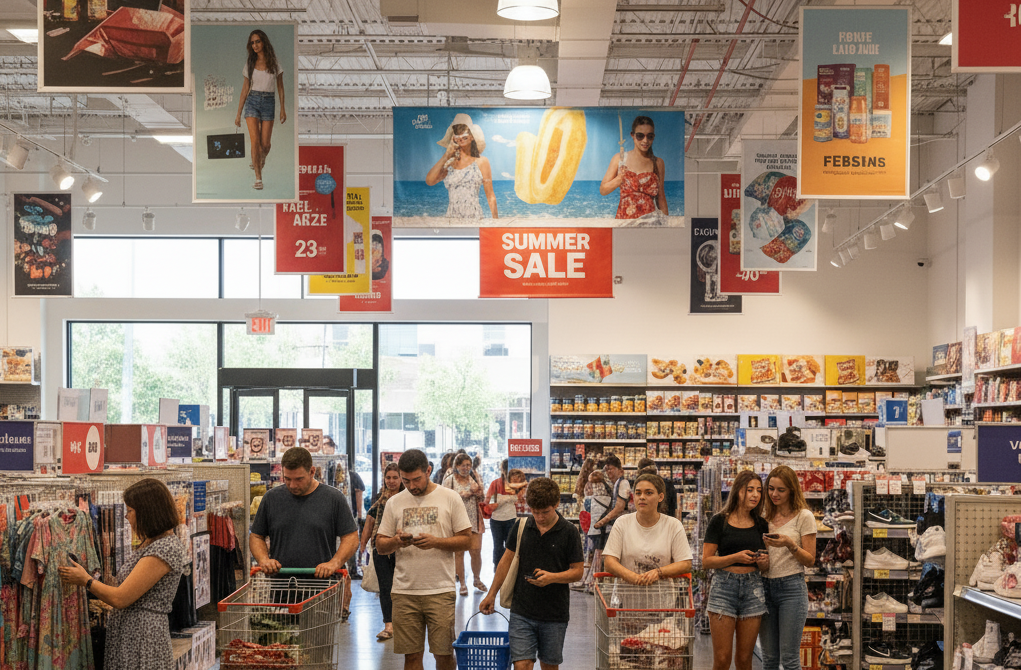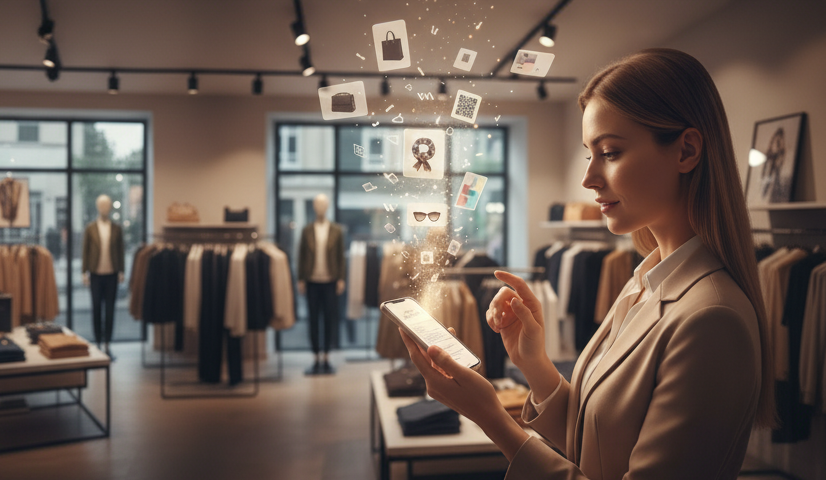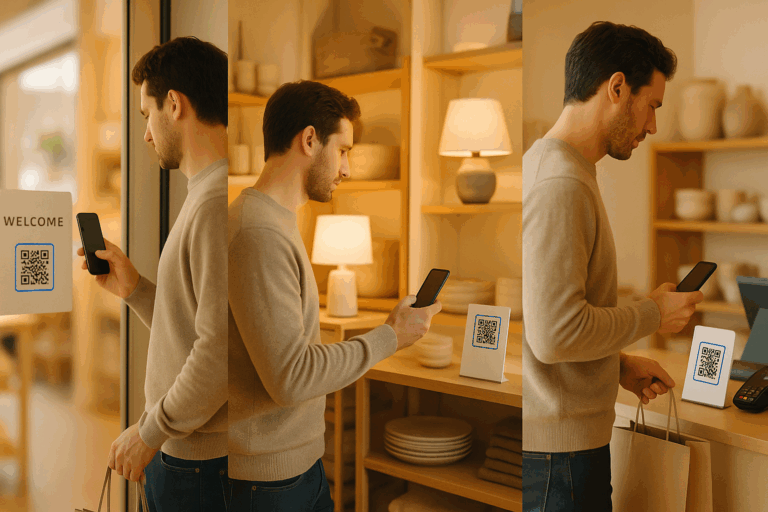Retail media is having a moment. Actually, scratch that. It’s having an era.
European retail media spending hit €13.7 billion in 2024, growing at 21% while the broader ad market crawled along at 6%. By 2028, it’s projected to reach €31 billion. For context, retail media now accounts for roughly one-fifth of all digital advertising in Europe. That’s a fundamental shift in how brands reach customers.
But here’s the strange part: nearly all of it is happening online.
While e-commerce platforms rake in ad dollars with surgical precision, physical stores (which still drive around 70% of global retail sales) remain largely locked out of the party. The very places where customers browse, decide, and buy are sitting on the media sidelines, armed with little more than shelf wobblers and the occasional cardboard cutout.
It’s a bit like owning prime real estate in central London and renting it out as storage space.
The question isn’t whether offline retail media is valuable. It’s why it’s taken this long to figure out how to unlock it.
How In-Store Marketing Has Been Done (And Why It’s Not Quite Cutting It)
Let’s be fair. Physical retail has always had its own version of marketing. Floor decals, endcap displays, sampling stations, strategic product placements, the occasional ambitious experiential activation. These things work. They catch eyes, they drive impulse buys, they create theatre.
But they’re also fragmented, expensive, and impossible to measure with any real precision.

You can’t tell who saw that display, whether they came back, or if they ignored it entirely because they were distracted by their phone. There’s no attribution loop, no audience segmentation, no performance dashboard. Just the occasional footfall counter.
And then there’s the clutter problem. Walk into most stores and you’re hit with so many competing messages that the net effect is visual noise. Too much, too loud, all at once, all shouting for the same fleeting moment of attention.
The result? In-store marketing has always felt a bit stuck in 2005, while online advertising sprinted ahead into data-driven precision, closed-loop attribution, and performance measurement that would make a CFO weep with joy.
Offline retail deserves better. And now, it’s finally getting it.
Enter Digital Receipts: The Quiet Revolution in Retail Media
Here’s a question: what’s the one thing every single customer gets at the end of a transaction?
A receipt.
Not a maybe. Not if they’re in the mood. Every time. It’s a guaranteed, universal touchpoint. And for decades, we’ve treated it like a legal obligation and nothing more. A piece of thermal paper destined for the bin, the back of a drawer, or that weird pocket dimension where receipts go to fade into illegibility.
But digital receipts?
They’re not just paperless convenience or a token sustainability gesture (though they are both of those things). They’re a new category of retail media. A high-intent, post-purchase, data-rich, fully measurable marketing channel that sits right at the most valuable moment in the customer journey: immediately after they’ve bought from you.
Think of it like this. Online, the confirmation email is prime real estate. Brands stuff it with recommendations, loyalty prompts, reviews requests, upsell offers. It’s a mini media channel in itself. Digital receipts do the same thing for physical retail, but better. Because unlike an email that arrives later, a digital receipt is instant. It’s contextual. It’s the very last interaction before the customer walks out the door.
And unlike traditional in-store marketing, it’s measurable, targetable, and scalable.

Why Digital Receipts Are Perfect as a Retail Media Channel
Let’s break down what makes digital receipt marketing such a natural fit as an offline retail media channel.
Monetization Opportunities
Here’s where it gets commercially interesting. Retailers can turn the digital receipt into an owned media property. Sell ad space to brand partners. Run co-branded campaigns. Offer sponsored placements. Think CPG brands paying to appear on receipts where their competitors were just purchased. Or complementary product recommendations from non-competing brands.
It’s a new revenue stream that sits on top of existing transactions, with zero additional cost to the retailer beyond the platform itself.
In the US, in-store retail media accounted for less than 1% of total retail media spend in 2024. That’s untapped potential on a staggering scale.
Guaranteed Reach
Every transaction equals one impression. If someone buys, they get a receipt. That’s nearly a 100% visibility in a world where most in-store media can only dream of that kind of reach.
Data-Driven Personalization
Digital receipts don’t just show what someone bought. They enable retailers to collect first-party data progressively and anonymously, building customer profiles over time. That means you can serve contextually relevant content based on actual purchase behaviour, not guesses. Someone just bought running shoes? Great. Show them socks, a marathon training app, or a sports nutrition brand partnership. No spam – that’s useful and they’ll love you.
And because it’s first-party, GDPR-compliant data captured at the point of sale, it’s clean, permissioned, and valuable in a post-cookie world.
Attribution and Measurability
Here’s the bit that makes finance teams sit up straight. With digital receipts as a retail media channel, you can finally track engagement and click-through, opt-ins, and conversions with the same rigour as online campaigns. Did the beverage brand’s ad get more views this week for their new flavour? You’ll know. Precisely.
Suddenly, physical retail advertising isn’t a black box anymore. It’s performance marketing.
Sustainability and Operational Ease
Let’s be honest – the constant printing, reprinting, and shipping of in-store posters, banners, and shelf talkers isn’t exactly a green operation. Most of it ends up as waste the moment a campaign changes. Digital receipts flip that equation. It’s a smarter, more sustainable way to communicate, and it signals a brand that values efficiency as much as impact.
And believe us, your customers are noticing.
This Might Interest You: Digital Receipts vs Paper Receipts: What’s Best for Modern Retailers?
Let’s Address the ‘Yeah, But…’
Of course, any new channel comes with scepticism. Let’s address it.
“Customers won’t engage with receipts.”
They already do. refive clients see high engagement rates with stores hitting over 60%. Because it’s immediate, contextual, and often contains something valuable. A loyalty sign-up, an offer, product care information. People engage when there’s a reason to.
“Privacy is a concern.”
It shouldn’t be, if it’s done right. Data collection through digital receipts is fully GDPR/CCPA compliant. Nobody’s tracking individuals without consent. It’s smart, permissioned engagement.
“Implementation sounds complex.”
It’s not. Most digital receipt platforms integrate directly with existing POS systems. No new hardware, no staff retraining, no months-long rollout. Refive, for instance, goes live in under 30 days. That’s faster than most loyalty programs and infinitely simpler than ripping out and replacing your entire checkout infrastructure.
“It’s just another upsell tactic.”
Sure, but it’s done right. When digital receipts feature partner brands, new product launches, or category-relevant promotions, it’s not intrusive – it’s contextual. It’s media with intent. If the message aligns with what the shopper just bought, it doesn’t feel like an ad at all. It feels like relevance and that’s the kind of marketing nobody minds seeing.
The Future: Connected, Measurable, Sustainable In-Store Marketing
So where does this go?
Digital receipts as a retail media channel aren’t a standalone tactic. They’re a foundational piece of a much larger shift: the integration of offline retail into the same data-driven, performance-measured, customer-centric ecosystem that e-commerce has lived in for years.
Imagine a world where every physical store operates like an e-commerce site. Where you can A/B test in-store promotions. Where brand partnerships are measured by actual conversion, not foot traffic estimates. Where marketing spend is allocated based on real ROI, not gut feel and last year’s budget.
The receipt doesn’t have to be just a transaction record – use it as the bridge between commerce and communication.
Because ultimately, that’s what this is about. Every checkout is both a sale and a storytelling moment. And digital receipts turn that moment into a measurable, monetizable, meaningful connection.
Also Read: How to Create a Store Experience That Brings People Back in 2025
Adopt the Next Big Retail Media Channel
Retail media is booming. The offline opportunity is massive, underserved, and ripe for transformation.
Digital receipts are a new media channel embedded in every transaction. They deliver what traditional in-store marketing can’t: reach, data, measurement, and personalization, all in one scalable, sustainable package.
Refive has spent years perfecting this. Working with brands like Puma, Gusti Leather, and ExtraShop to prove that digital receipts are a strategic asset.
We’ve built the platform, solved the integration challenges, and demonstrated the results. Now we’re helping retailers and brands unlock what’s next: turning every store into a data-driven, customer-centric, revenue-generating media environment.
Because the future of in-store marketing isn’t louder. It’s smarter. And it starts the moment someone says “thanks” and walks away with a receipt in their pocket.
Only now, that receipt is working long after they’ve left the store.
Want to explore how digital receipts can transform your retail media strategy? Let’s talk. Get in touch with refive and see what’s possible when every transaction becomes an opportunity.
- What is offline retail media?Offline retail media refers to advertising and promotional space within physical retail environments. Unlike online retail media (ads on e-commerce platforms like Amazon), offline retail media includes in-store displays, digital screens, point-of-sale advertising, and increasingly, digital receipts. It allows brands to reach customers at the moment of purchase in brick-and-mortar stores, using the same data-driven targeting and measurement principles that work online.
- Can digital receipts be used for retail media?Yes. Digital receipts function as a retail media channel by providing ad space immediately after a purchase. Retailers can sell placements to brand partners, display personalized offers, or promote complementary products directly on the receipt. Because every customer receives a receipt, it guarantees nearly a 100% reach with measurable engagement, making it highly effective for both retailer monetization and brand advertising.
- Is receipt advertising effective?Yes, when done well. Digital receipt engagement rates are high, with some retailers seeing over 60% interaction rates. This outperforms typical email open rates because receipts are contextual, immediate, and often contain value (loyalty points, offers, product care info). The key is relevance. Generic ads perform poorly, but personalized content based on actual purchase behaviour drives strong engagement and conversion.
- How can retailers monetize digital receipts?Retailers can monetize digital receipts by selling ad placements to brand partners (CPGs, complementary brands), charging for sponsored product recommendations, or offering data insights to advertisers based on anonymized purchase behaviour. Common models include cost-per-click (CPC), cost-per-acquisition (CPA), or flat-fee sponsorships. Platforms like Refive enable retailers to activate this without building the infrastructure themselves, making it accessible even for mid-sized retail chains.
- What are the main retail media opportunities in physical stores?Physical stores offer several retail media opportunities: digital receipts, in-store screens, shelf-edge displays, audio advertising, and checkout zone placements. Digital receipts stand out because they reach every customer, require no additional hardware, and provide measurable attribution. Other opportunities include partnerships with CPG brands for co-marketing, sponsored product placements, and leveraging first-party purchase data for targeted off-site campaigns.









